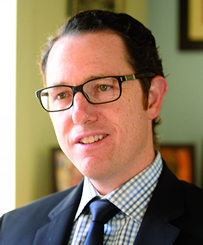Medical biosensors have shrunk, becoming wearable for everyday clinical use, and the data they collect can be just as surprising as the devices are novel.

“We are conducting a study monitoring people with rheumatoid arthritis being treated with etanercept,” said Brennan Spiegel, MD, MSHS, Director of Health Services Research for the Cedars-Sinai Health System, Director of the Cedars-Sinai Center for Outcomes Research and Education, and Professor of Medicine and Public Health at the University of California Los Angeles. “We are monitoring how they are feeling using patient-reported outcomes, or PROs, and comparing those measurements, like pain and fatigue, with how patients are physically performing via biosensors, measured as patient-reported informatics, or so-called PRIs.”
Dr. Spiegel will discuss some of the unexpected insights coming from one of the first formal rheumatology studies incorporating wearable biosensors during a clinical symposium on Wearable Biosensors to Advance Rheumatology from 7:30 – 8:30 am Monday. He will be joined by Jeffrey R. Curtis, MD, MS, MPH, William J. Koopman Endowed Professor in Rheumatology and Immunology at the University of Alabama Birmingham School of Medicine, Director of the UAB Arthritis Clinical Intervention Program, and Co-Director of the UAB Center for Education and Research on Therapeutics of Musculoskeletal Disorders and the UAB PharmacoEpidEmology and phaRmcoeconimcs Unit.
Adding wearable biosensors to clinical research and practice may seem like a natural expansion of current techniques and methodologies, Dr. Spiegel said. Patients and rheumatologists routinely use smartphones and other devices that incorporate many of the technologies found in wearable biosensors.
“In traditional clinical care, we take care of people within the four walls of a clinic or an office or a hospital room, but 99.9 percent of people’s lives are spent outside those walls,” he said. “The whole concept of mobile health and wearable biosensors is that we can reach out beyond those familiar walls to understand what is happening to people in their real lives. That provides a fundamentally new approach to monitoring.”
But incorporating new technologies and new data streams into medical research and practice is anything but straightforward. The very first patient enrolled in the Cedars-Sinai wearable biosensor etanercept trial, for example, upended expectations.
The trial includes ankle sensors with gyroscopes to monitor physical movements such as range of motion, minimum and maximum acceleration of movement, and the number of steps. The initial patient reported that her pain, fatigue, and joint stiffness improved with etanercept. But instead of showing increased movement and activity as expected, her biosensors showed progressively less movement as treatment continued. Within a short period of time, she was nearly immobile most of the day.
“We thought there must be some mistake, some malfunction,” Dr. Spiegel said. “But when we interviewed the patient, she told us etanercept was so effective that she was able to get back to work. Because she is a writer, feeling better meant that she could sit down and work for hours on end without pain. That blows right out of the water our presupposition that more effective treatment for RA means people will move more. For this patient, effective treatment let her move less. Those are the kinds of surprises we are all encountering and trying to understand as we gain experience with wearable biosensors.”
Interest continues to grow in incorporating wearable biosensors into rheumatology research and practice, he said, but despite the intense interest and persuasive logic, little rigorous evidence supporting their wide-scale use exists.
“Just as with every other biomedical advance, we need meticulous research and careful observation to understand the basic proposition of incorporating wearable biosensors in clinical trials,” he said. “At the same time, no other specialty has more at stake than rheumatology. Wearable biosensors are about activity, movement, and physical function, the primary outcomes of interest for many of our diseases. We need to understand the shortcomings, the pitfalls, the perils of getting too excited about this new technology too quickly. But where there is hype, there is also hope. I am hopeful that with the right patient-centered research, we can begin to answer pressing questions about the role of wearable biosensors in everyday clinical practice.”


